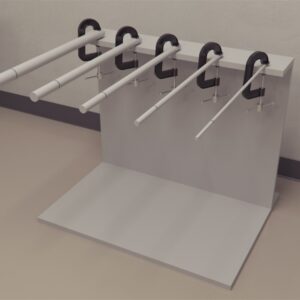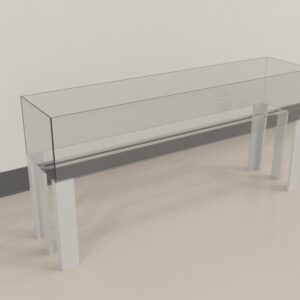$1,490.00 – $1,590.00Price range: $1,490.00 through $1,590.00
The pivotal study on whisker-guided exploration involved the use of rats. The maze assesses voluntary exploration within an oval track, observing reductions in the number of rearing behaviors and direction changes. Injured rats showed alterations in their preferred locations, spending more time on the inner side of turns compared to the outer side. Additionally, an increase in thigmotaxis was anticipated following both sham procedures and brain injuries.

MazeEngineers empowers preclinical neuroscience research with meticulously designed, customizable behavioral apparatuses. From manual classic mazes to fully automated smart systems, we provide the tools scientists need to capture high-quality, reproducible data for studies on learning, memory, anxiety, and depression.

bool(false)


Mouse Features |
Width: 17cm |
Outer Length: 67cm |
Width: 53cm |
Height: 20cm |
Multiple colors available |
Starter box |
Rat Features |
Width: 25cm |
Outer Length: 100cm |
Width: 80cm |
Height: 30cm |
Multiple colors available |
Starter box |

The Whisker-Guided Exploration Task is conducted to assess somatosensory deficits in rodent disease models. This task relies on the rodent’s whiskers, where the subject navigates an oval track by using thigmotaxic scanning. The Whisker-Guided Exploration Task helps in investigating the underlying mechanisms and anatomical structures involved in somatosensory circuit alterations. Additionally, this task is useful for evaluating the effectiveness of therapeutic interventions aimed at mitigating chronic pathological conditions associated with brain injury.
Whiskers serve as highly sensitive sensors, enabling rodents to create a spatial map of their surroundings, differentiate between textured surfaces, and locate objects. The somatosensory circuit in the brain regulates the rhythmic sweeping movements of whiskers (Petersen, 2007). Traumatic brain injury can significantly damage this circuit, leading to impaired whisker sensitivity for surface discrimination and object detection.
The apparatus used for the whisker-guided exploration consists of an oval track and a starting box, with black-painted walls and white geometric shapes designed to challenge the rodent’s sensory perception. As the subject moves through the straight sections and corners of the track, it identifies different geometric shapes using its whiskers. Other tasks that assess whisker-based somatosensory behaviors include the Angle Entrance Task and the Gap Cross Test.
The whisker-guided exploration apparatus features an oval track that is 25 cm wide, consisting of both straight paths and turning corners. The straight sections of the track measure 50 cm in length on the outer side and 30 cm on the inner side. The corners are shaped by outer walls that are 30 cm long and inner walls that are 10 cm long. All the walls in the apparatus stand 30 cm high. The walls are painted black, adorned with white geometric shapes positioned at regular intervals along the track. The entire apparatus rests on a base that is 100 cm long and 80 cm wide, with a start box located on the longitudinal side of the setup.
Clean the apparatus thoroughly prior testing. An external tracking and recording system such as Noldus Ethovision XT can be used with the whisker guided exploration apparatus for recording the subject’s behavior.
Place each subject individually in the start box and allow it to acclimate to the apparatus for 5 minutes.
Place the subject individually in the start box of the apparatus. Allow the subject to explore the track for 10 minutes. Repeat the procedure for other subjects.
Learoyd and Lifshitz (2012) evaluated Sprague-Dawley rats in the whisker guided exploration task to analyze somatosensory behavior alterations. Subjects were divided into two groups; One group underwent fluid percussion injury (FPI) whereas the other group underwent Sham procedure and acted as the control. The animals were tested on a whisker guided exploration task before the injury, and 1 and 4 weeks after injury. Results indicated a significant increase in exploration time post-injury in both treatment groups. FPI treated subjects spent more time in the inside of a corner than the sham group in the post-surgery evaluation. The number of rears and reversals also significantly reduced in the FPI treated group as compared to pre-surgery recordings.
Following parameters can be recorded while using whisker guided exploration task
The whisker-guided exploration task is a valuable method for investigating sensory deficits in subjects with traumatic brain injury. This procedure is straightforward to administer, affordable, and time-efficient. It requires no prior training for the subjects before testing, making it a convenient option. Being non-invasive, the task poses no physical risk to the subjects. The whisker-guided exploration task delivers consistent and reliable results across a wide array of studies, from identifying the causes of brain dysfunction to evaluating recovery processes.
Apparatus novelty diminishes with repeated or extended trials. The whisker-guided exploration task is typically performed under bright overhead lighting, which could provide visual cues to the subjects. To address this issue, the observation period should be kept brief, and video recording should be conducted under red or dim lighting to minimize any potential disruption to the subjects’ behavior. Proper cleaning of the apparatus is essential to remove any residual olfactory cues or other disturbances that could influence the subjects’ performance. It’s important to use subjects of similar age, gender, and strain to maintain consistency in exploratory behavior during the test. Additionally, improper handling of the subjects can induce stress or anxiety, which could significantly affect their performance in the task.
Selection of proper strain, age, and sex of subjects is important to prevent variation in exploratory behavior in a whisker guided exploration task.
| Species | Mouse, Rat |
|---|
There are no questions yet. Be the first to ask a question about this product.